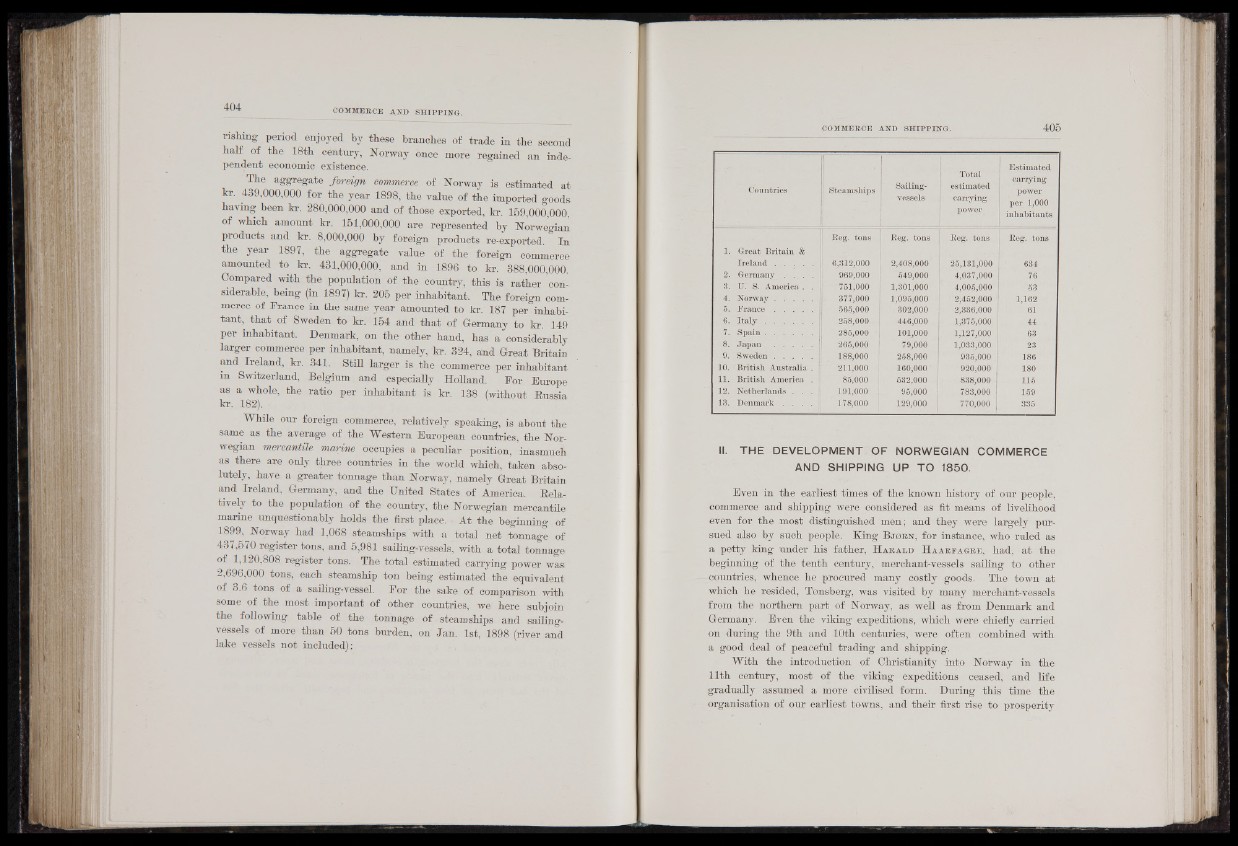
rishing period enjoyed by these branches of trade in the second
half of the 18th century, Norway once more regained' an inde-
pendent economic existence.
The aggregate foreign commerce of Norway is estimated at
kr. 439,000,000 for the year 1898, the value of the imported goods
having been kr. 280,000,000 and of those exported, kr. 159,000,000,
of which amount kr. 151,000,000 are represented by Norwegian
products and kr. 8,000,000 by foreign products re-exported. In
the year 1897, the aggregate value of the foreign commerce
amounted to kr. 431,000,000, and in 1896 to kr. 388,000,000.
Compared with the population of the country, this is rather considerable,
being (in 1897) kr. 205 per inhabitant. The foreign commerce
of France in the same year amounted to kr. 187 per inhabitant,
that of Sweden to kr. 154 and that of Germany to kr. 149
per inhabitant. Denmark, on the other hand, has a considerably
larger commerce per inhabitant, namely, kr. 324, and Great Britain
and Ireland, kr. 341. Still larger is the commerce per inhabitant
in Switzerland, Belgium and especially Holland. For Europe
as a whole, the ratio per inhabitant is kr. 138 (without Russia
kr. 182).
While our foreign commerce, relatively speaking, is about the
same as the average of the Western European countries, the Norwegian
mercantile maryne occupies a peculiar position, inasmuch
as there are only three countries in the world which, taken absolutely,
have a greater tonnage than Norway, namely Great Britain
and Ireland, Germany, and the United States of America. Relatively
to the population of the country, the Norwegian mercantile
marine unquestionably holds the first place. • At the beginning of
1899, Norway had 1,068 steamships with a J o ta l net tonnage of
437,570 register tons, and 5,981 sailing-vessels, with a total tonnage
of 1,120,808 register tons. The total estimated carrying power was,
2,696,000 tons, each steamship ton being estimated the equivalent
of 3.6 tons of a sailing-vessel. For the sake of comparison with
some of the most important of other countries, we here subjoin
the following table of the tonnage of steamships and sailing-
vessels of more than 50 tons burden, on Jan. 1st, 1898 (river and
lake vessels not included):
Countries Steamships Sailingvessels
Total
estimated
carrying
power
Estimated
carrying
power
per 1,000
inhabitants
1. Great Britain &
Reg. tons Reg. tons Reg. tons Reg. tons
2,408,000 26,131,000 634
2. Germany . . . . 969,000 549,000 4,037,000 76
3. U. S. America . . 761,000 1,301,000 4,005,000 53
4. N o rw a y ................. 377,000 1,095,000 2,452,000 1,162
5. France . . . . . 565,000 302,000 2,336,000 61
6. I t a l y ..................... 258,000 446,000 1,375,000 44
7. S p a in ..................... 285,000 101,000 1,127,000 63
8. J a p a n ................. 265,000 79,000 7 1,033,000 23
9. Sw e d e n ................. 188,000 258,000 935,000 186
10. British Australia . 211,000 160,000 920,000 180
11. British America . 85,000 532,000 838,000 115
12. Netherlands . . . 191,000 95,000 783,000 169
13. Denmark . ~. . . 178,000 129,000 770,000 335
II. THE DEVELOPMENT OF NORWEGIAN COMMERCE
AND SHIPPING UP TO 1850.
Even in the earliest times of the known history of our people,
commerce and shipping were considered as fit means of livelihood
even for the most distinguished men; and they were largely pursued
also by such people. King B j o r n , for instance, who ruled as
a petty king under his father, H a r a l d H a a r p a g r e , had, at the
beginning of the tenth century, merchant-vessels sailing to other
countries, whence he procured many costly goods. The town at
which he resided, Tonsberg, was visited by many merchant-vessels
from the northern part of Norway, as well as from Denmark and
Germany. Even the viking expeditions, which were chiefly carried
on during the 9th and 10th centuries, were often combined with
a good deal of peaceful trading and shipping.
With the introduction of Christianity into Norway in the
11th century, most of the viking expeditions ceased, and life
gradually assumed a more civilised form. During this time the
organisation of our earliest towns, and their first rise to prosperity